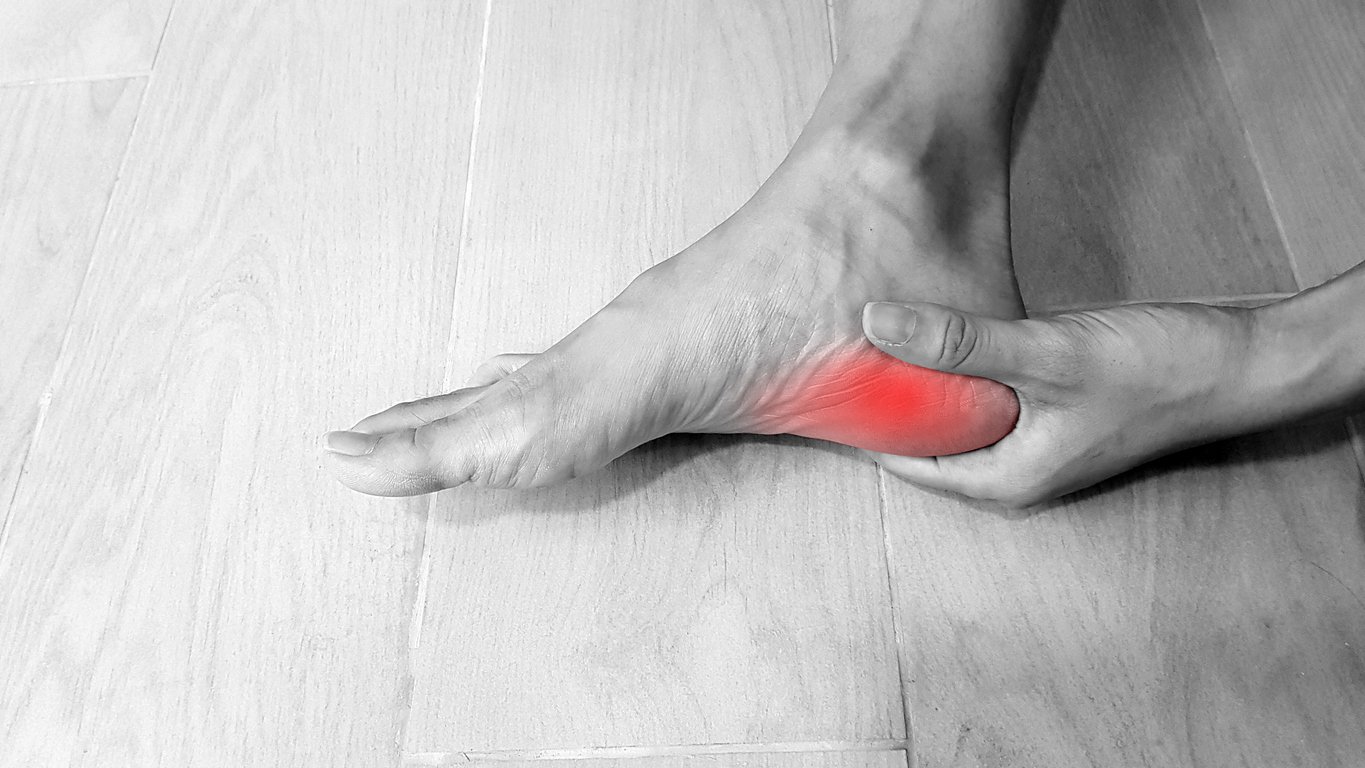Have you ever experienced a sharp, stabbing pain in your heel when you get out of bed in the morning or stand up after sitting for a while? This could be a sign of plantar fasciitis, a common condition that affects millions of people every year. In this post, we explore everything you need to know about plantar fasciitis, from its definition and anatomy to common risk factors and causes. We also discuss the early signs and progression of symptoms, as well as diagnostic methods that can help determine if you have this condition. Finally, we cover various treatment options available for plantar fasciitis, including nonsurgical methods and surgery. So, read on to learn more about how to manage and prevent plantar fasciitis.
Understanding Plantar Fasciitis
Plantar fasciitis, an inflammation of the tissue on the bottom of the foot, causes pain primarily in the heel due to small tears in the plantar fascia. Risk factors include long periods of standing, obesity, and tight calf muscles, affecting the arch of your foot. The pain is most severe with the first step in the morning or after prolonged inactivity.
Defining Plantar Fasciitis
Plantar fasciitis, an inflammation of the tissue from the heel bone to the arch of your foot, causes stabbing pain in the heel area. It’s common in runners and those with flat feet or high arches. The pain is most intense in the morning and after standing for long periods. The good news is that it can be treated with simple treatment methods, such as rest, using ice, and taking ibuprofen. Steroid injections and PRP therapy are also effective treatments.
Anatomy Related to Plantar Fasciitis
Supporting the arch of your foot and absorbing shock, the plantar fascia is akin to a rubber band under stress. It connects to the calf muscles and Achilles tendon, crucial for arch support and mobility. Overuse, high arches, obesity, and tight calf muscles can result in irritation, degeneration, and inflammation. Simple treatment methods like rest, ice, stretching, and wearing supportive footwear are often recommended.

Causes of Plantar Fasciitis
Excessive stretching, tiny tears, or inflammation of the plantar fascia causes plantar fasciitis. Inadequate shoe support and walking barefoot on hard surfaces also contribute. Physical activities stressing the heel bone and foot tissues, tight calf muscles, high arches, obesity, and prolonged standing are risk factors. Inactivity, bone spurs, flat feet, and tight gastrocnemius muscles can lead to plantar fasciitis.
Common Risk Factors
Excessive body weight, high or low arches, and tight calf muscles all pose a risk for plantar fasciitis. Inappropriate arch support or frequently wearing high heels can also lead to this condition. Prolonged periods of standing or walking on hard surfaces, especially concrete, increase the likelihood of developing plantar fasciitis. Additionally, engaging in activities that exert repetitive stress on the heel bone may result in this painful condition. Rarely, complications from arthritis or degeneration of the plantar fascia may cause plantar fasciitis.
Role of Footwear in Plantar Fasciitis
Proper footwear, including good arch support, can ease plantar fasciitis symptoms. Well-cushioned shoes with support in the heel, arch, and ball of the foot benefit sufferers. Conversely, high-heeled or flat shoes without arch support worsen plantar fasciitis pain. Custom orthotics, inserts, or heel cups within shoes can reduce discomfort. Supportive footwear with shock absorption is essential for managing plantar fasciitis pain.
Symptoms Indicating Plantar Fasciitis
Symptoms indicating plantar fasciitis commonly include a stabbing pain in the bottom of the heel, most severe with the first step in the morning or after inactivity. Pain worsens after physical activity and may be accompanied by stiffness, tightness, and inflammation in the heel and arch of the foot. The presence of a heel spur can cause additional pain in the bottom of the heel alongside plantar fasciitis pain.

Early Signs
Pain in the bottom of the heel, especially in the morning, is an early sign of plantar fasciitis. This stabbing pain may subside as the foot limbers up. Additionally, discomfort in the arch of the foot, tightness, stiffness, and inflammation are common indicators. The first step after inactivity is typically the most painful for sufferers, and a heel spur can cause additional discomfort in the heel.
Progression of Symptoms
As plantar fasciitis progresses, the pain in the bottom of the heel and arch of your foot intensifies, often leading to difficulty in walking, running, or standing for long periods. The stabbing pain is usually the first symptom, followed by discomfort in the arch, tightness, inflammation, and stiffness. Without treatment, the symptoms worsen, emphasizing the importance of early intervention and the best treatment methods available.
Diagnostic Methods for Plantar Fasciitis
When diagnosing plantar fasciitis, healthcare professionals conduct a physical examination and use imaging techniques such as MRI, X-ray, and ultrasound. These methods help identify the causes of pain associated with the condition. Additionally, ultrasound, physical therapy, and professional examination are essential for accurate diagnosis and to determine the best treatment plan. Using a combination of these diagnostic methods ensures a comprehensive understanding of the underlying factors contributing to plantar fasciitis.

Professional Examination
Professional examinations serve as comprehensive assessments of your skills and knowledge, validating your expertise in the field. Covering a wide range of topics, these exams ensure thorough evaluations and are often required for successful completion of certification courses. Taking a professional examination marks a significant step in career advancement, making it an essential aspect of professional growth and development.
Use of Imaging Tests
Imaging tests, such as X-rays, aid in accurate plantar fasciitis diagnosis. Ultrasound is common for visualizing the plantar fascia, while MRI provides a detailed view of foot tissue. These tests help determine the severity and identify the cause of plantar pain without beginning with ‘plantar fasciitis causes’.
Treatment Options for Plantar Fasciitis
Stretching exercises for the calf muscles and plantar fascia are nonsurgical treatment options. Physical therapy effectively relieves plantar fasciitis symptoms. Custom orthotics provide long-term relief, while night splints prevent morning heel pain. Incorporating shoe inserts is essential for treatment.
Nonsurgical Methods
When dealing with plantar fasciitis, nonsurgical options prioritize pain relief and reducing inflammation. Incorporating stretching exercises and physical therapy help in strengthening the foot’s muscles and tissues. Custom orthotics provide a non-invasive approach to managing plantar fasciitis pain, aiming to alleviate symptoms without surgical intervention. These nonsurgical methods offer good news for individuals seeking simple treatment methods without the need for invasive procedures.

Is Surgery a Viable Option for Plantar Fasciitis?
Surgery may be considered for plantar fasciitis when nonsurgical treatments fail. This option involves releasing the tight plantar fascia tissue or performing a gastrocnemius recession to relieve tension in the calf muscles. Surgery is typically a last resort tailored to each individual’s needs.
How long does plantar fasciitis last?
Plantar fasciitis can persist for months or longer without proper treatment. The duration varies based on severity, individual factors, and intervention. Effective treatment methods significantly reduce the time it takes for symptoms to resolve. Seeking timely medical attention is crucial in addressing the duration of plantar fasciitis symptoms.
How can I prevent plantar fasciitis?
To prevent plantar fasciitis, it’s important to wear supportive footwear and regularly stretch the calf muscles and plantar fascia. Avoid long periods of standing on hard surfaces and maintain a healthy body weight. Engaging in low-impact activities can also help prevent this foot condition.

Should you rub plantar fasciitis?
Rubbing or massaging plantar fasciitis is generally not recommended as it can aggravate inflammation and cause more pain. Instead, try gentle stretching exercises and icing the area to reduce pain and promote healing. It’s best to consult a healthcare professional for proper treatment.
How do professional athletes deal with Plantar Fascitis?
Professional athletes often manage Plantar Fasciitis through physical therapy or corticosteroid injections. Rest and proper footwear are crucial for athletes dealing with the condition. Taping or bracing the foot can provide support and alleviate pain. Ice, massage, and stretching exercises may also be used to manage symptoms.
Can genetics play a role in developing plantar fasciitis?
Genetics can contribute to developing plantar fasciitis. Certain foot structures or abnormalities may increase susceptibility. Other risk factors include obesity, repetitive activities, and improper footwear. Proper diagnosis and treatment, including stretches and orthotics, can help manage the condition.

Conclusion
In conclusion, understanding the causes of plantar fasciitis is crucial for early detection and effective treatment. Common risk factors such as age, weight, and excessive physical activity can contribute to the development of this condition. Additionally, wearing improper footwear can put unnecessary strain on the plantar fascia, leading to inflammation and pain.
Recognizing the early signs of plantar fasciitis, such as heel pain and stiffness, can help prevent the condition from progressing. If you suspect you have plantar fasciitis, it is recommended to seek professional examination and consider nonsurgical treatment options. Remember, prevention is key, so maintaining a healthy weight, wearing supportive shoes, and incorporating stretching exercises into your routine can help reduce the risk of developing plantar fasciitis.
I hope you found this blog helpful and please feel free to comment an share.
Thanks for reading!
 | Tracy J. Founder, The heel GP |
